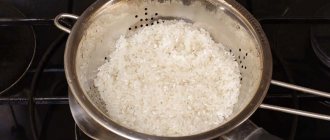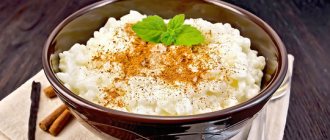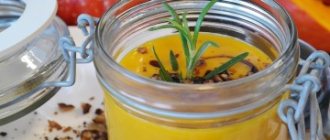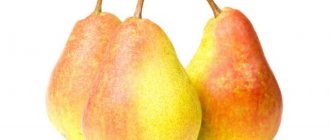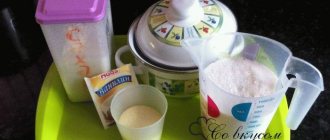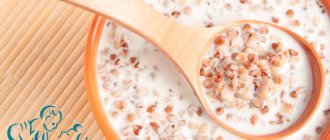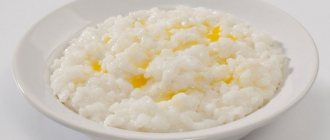Rating: No rating
Already from 6 months the baby is ready to receive the first complementary foods. What to choose as the first products depends on the characteristics of the baby. If you are overweight or have problems with the gastrointestinal tract, manifested by constipation, then the first “adult” food should be vegetables.
If the baby, on the contrary, is underweight, then the first complementary food will be porridge. One of the best grains for a baby’s body, which can be used to prepare milk porridges, is rice.
The benefits and harms of rice porridge for infants
Rice dishes are suitable for most people, including children. Therefore, baby nutrition experts recommend giving it to children when they reach six months of age.
If properly introduced to rice, it can give them many benefits:
- normalizes the functioning of the excretory system and gastrointestinal tract;
- cleanses the child’s body of toxins;
- has a positive effect on the nervous system;
- replenishes the body's reserves of nutrients.
This cereal is rich in vitamins B, PP, H, E. It also contains compounds of potassium and iron, magnesium and zinc, selenium and iodine, and silicon. Amino acids such as leucine, lysine, phenylalanine, valine and others are also present in rice grains.
The presence of complex carbohydrates further increases the value of the product. It contains starch, pectins and fiber.
The delicate viscosity of rice porridge will have a good effect on the child’s body, and a 1-year-old child should definitely eat it. It promotes baby energy and good weight gain.
Allergies to rice are rare, since this grain is neutral in most cases. Even if an undesirable reaction appears after this porridge, fruit additives are often to blame. The harm of rice cereal if consumed frequently is that it can cause constipation. This cereal also contains phytic acid, which reduces the absorption of iron and calcium. Children who cannot tolerate fiber may experience stomach cramps and nausea.
We use a slow cooker
In addition to the usual method of preparing porridge on the stove, you can use the recipe in a slow cooker.
- milk – eight hundred ml;
- two tbsp. spoons of sugar;
- salt;
- a glass of rice cereal;
- butter - thirty grams.
- Rice is washed thoroughly and poured into a bowl.
- Pour in milk, add sugar, as well as salt and butter. Everyone is stirred.
- Set the “Porridge” mode. It takes twenty-five minutes to prepare. After which you can still switch to “heating” for about ten minutes.
Now you know the recipe for rice porridge. Remember, if your baby is allergic to milk, you can prepare a dairy-free version. For a toddler over a year old, do not forget to experiment, adding new ingredients each time, thereby making his menu more varied.
Rice porridge is one of the first complementary feeding options. It is recommended that bottle-fed babies try it at six months, and infants at 7-8 months. The mother will have to decide at what age to offer porridge to the child independently or taking into account the opinion of the doctor. An intelligent pediatrician will tell you when to introduce complementary foods and advise how to cook rice porridge for a child who does not yet have teeth, whose chewing reflex is poorly developed, and whose digestive system is sensitive.
When to introduce into complementary foods
Since rice porridge can be used as a second, and sometimes, in case of stool problems in a child, as the first cereal complementary food, its introduction into the child’s diet will be around 6-7 months for infants. Artificial cats can be accustomed to this product as early as 5 or 6 months.
There are several reasons why rice porridge is a good introduction to cereals in the first place:
- This is a gluten-free product and is hypoallergenic;
- complex carbohydrates provide energy;
- the presence of starch helps coat the mucous membrane of the digestive organs and normalizes the microflora;
- By this age, the baby already has enough level of enzyme activity in the gastrointestinal tract for good absorption of this product.
To successfully introduce a baby to rice porridge, parents require patience and knowledge of the rules of complementary feeding.
Congee
The rice water recipe will be useful for mothers when the baby has an upset stomach and is put on a gentle diet. The decoction saturates, has a binding effect, envelops the walls of the stomach, and prevents the activity of pathogenic bacteria.
To prepare, pour 1.5 tbsp. rice with water, leave to swell for a while. At the same time, boil 500 ml. water, add the swollen cereal, cook for 40 minutes over low heat, stirring from time to time. Remove the broth from the stove, leave for a couple of hours, and filter. The cooled liquid (50-100 ml) is given to babies 4 times a day.
How to cook rice porridge for a baby
Having found out that rice porridge is an excellent dish for a baby, you need to figure out how to prepare it. When he grows up a little, pieces of fruit that are already familiar to the baby are added to the plate. Salt and sugar are added to the dish as seasoning only after a year.
In order for an older child to cook rice, the cereal is prepared as follows:
- Rinse with a large volume of water until the last liquid is clear. This removes the stickiness.
- Plain rice is poured with warm water and kept for half an hour. A variety of cereals with oblong grains is poured with boiling water for a quarter of an hour. Rinse for the last time with water at room temperature.
- The cereal is placed in a container and filled with twice the volume of boiling liquid (for 200 ml of rice, take 400 ml of water).
- Then mix thoroughly and especially use a spatula to “walk” along the bottom of the pan so that it does not stick.
- Cook for about half an hour, it depends on the volume of the contents of the container - the smaller the grains, the faster it becomes ready.
- At the end, you can rinse the cooked rice. This way they get rid of excess starch.
If the baby’s mother decides to prepare porridge for him on her own, then the first time pediatricians advise rubbing it by hand or with a blender.
Dish with pumpkin and milk
Pumpkin has a beneficial effect on digestive processes, so its appearance in a child’s diet, and even together with rice and milk, should have a positive effect on the baby’s well-being.
If the child is one year old, and he was previously familiar with both rice, pumpkin, and milk, adaptation was successful, and there are no allergies, then you can prepare porridge according to this recipe.
- milk - two glasses;
- pumpkin pulp - four hundred grams;
- half a glass of rice (round);
- teaspoon sugar;
- thirty grams of butter.
- After washing, the rice is boiled in water for ten minutes, until half cooked.
- Pumpkin is cooked in milk in a separate container.
- After the vegetable has become soft enough, you can add the prepared rice and sugar.
- Cook over low heat. Once cooked, add oil.
Popular cooking methods
Today, it is not often that mothers prepare rice cereal porridge for their child; most of them use factory-made ones. They are easy to dilute with water or a mixture, and they are ready for use.
This product also contains vitamins, minerals, and probiotics.
If mom decides to cook rice cereal herself, then she cooks it either with a milk base or with water. Rice, if necessary, is also ground into flour. Human milk or adaptation formulas are added to cooked dairy-free porridge.
Dairy
It is recommended that older children prepare porridge with whole milk, while infants are taught to eat a diluted product.
The recipe consists of the following ingredients:
- rice;
- water;
- milk.
Place prepared rice in a container and fill it with water. Bring to a temperature of 100 °C and simmer for 10 minutes. Then pour in milk in a thin stream and keep it on the stove for the same amount, while systematically stirring the dish. After cooking, it is infused under a lid so that the rice grains become more steamed. Finally, a homogeneous mass is made by grinding on a sieve. Add butter to the porridge.
Dairy-free
Rice milk porridge is more nutritious, but for the first feeding you need to cook the cereal in clean water. While getting acquainted with this cereal, the baby gets used to thicker food. If a child has an allergic reaction to cow's milk, then this recipe is used constantly.
Dairy-free rice porridge should be cooked as follows:
- Place the cereal in the pan according to the norm, fill it with water 4 times larger in volume and bring to a boil.
- Then reduce the heat and cook for about 30 minutes. This time is usually enough to simmer the porridge.
- After turning off, allow the product to brew under the lid for a quarter of an hour. Finally, rub through a sieve. A homogeneous porridge is also obtained by grinding raw rice grains.
Note to parents
Initially, it is enough for the baby to try 1 teaspoon of rice porridge. Gradually, the portion can be increased, bringing it to 100 grams by the age of one year. Before this age, the porridge should be rubbed through a sieve; after a year, it should be lightly crushed with a blender. For cooking, it is advisable to use a saucepan with a wide bottom, a lid and sealed walls. It is important to cook the dish over low heat, increasing it after boiling.
To make the baby's diet varied, add buckwheat, oatmeal, and corn porridge. You can alternate them every day, because they are well absorbed and help you grow strong and strong. If your child is reluctant to eat them, you can try additives and interest him in the spectacular presentation of the dish.
Useful tips
At the beginning of the period of introducing complementary foods, parents should be familiar with the basic advice of pediatricians:
- When a child is just being introduced to a new food, the unfamiliar dish should be given in the morning or before lunch. This is done due to the possible manifestation of allergies. In this case, all the body’s reactions will already manifest themselves by the evening.
- The initial portion of a new complementary food is half a teaspoon, and then it increases every day. After a week, the amount of food already reaches the norm.
- In order to reduce the risk of constipation, porridge is prepared with prune broth.
- The cooked dish cannot be stored - in the first year of life, the child is allowed to eat only freshly prepared food.
- It is advisable to give complementary foods to babies not from a pacifier, but with a baby spoon.
- Let the atmosphere while eating be comfortable: with goodwill and good mood.
Each mother independently determines what will be best for her child during this period, what cereal to choose and what recipe to cook according to. The main thing is that it is food made from quality ingredients and prepared with love.
“Frutonyanya”
Dairy-free porridge “Frutonyanya” is indicated from 4 months. Does not cause allergies, suitable for children who are lactose intolerant. Rich in vitamins, minerals and inulin - dietary fiber that can improve immunity by forming beneficial microflora.
Composition of porridge "Frutonyanya":
- rice flour;
- vitamins;
- minerals.
Recipe for making “Frutonyanya”: you need to pour 175 ml of water at a temperature of 40-50 degrees into a container, then add 25 grams (3 tbsp.) of dry product, stir with a fork until a lump-free consistency is achieved.
If your child requires a dairy-free porridge with a strengthening effect, choose Frutonyanya, which is not burdened with dietary fiber and fruit additives.
Allergy
Children often develop allergies when new foods are introduced. This could be an allergy to cow's or goat's milk protein, gluten, fruit, or sugar. Also, an undesirable reaction may be a consequence of rapid administration of large portions. Rarely there is an allergy to rice protein.
To prevent allergies from occurring, it is necessary to follow the recommendations for introducing complementary foods, carefully select products, follow the recipe and the proportions indicated in it.
If, nevertheless, the baby develops an allergy, and you find out for sure that this is a reaction to rice, then it should be removed from the menu for 14 days. After the symptoms disappear, try to choose only dairy-free single-ingredient cereals that do not cause allergies.
Industrially produced food is recommended to be given until the age of 12-15 months.
After this, it is expected to switch to home cooking. The choice is up to the parents. The main thing to remember is that the child’s health directly depends on you.
